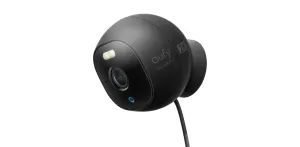Why a Fisheye Security Camera? Let's Dive In
Last summer, while binge-watching a tech review series that could probably double as a sleep aid (no offense to the host), I stumbled upon something that actually perked up my ears—a segment on fisheye security cameras. Now, before you yawn, hear me out. These aren't your run-of-the-mill security cameras. Imagine being able to see nearly everything around with just one camera. That's what got me thinking, maybe it’s time to beef up my home security without turning my living room into a mini surveillance hub.
For those new to this, a fisheye camera is a bit of a marvel in the world of home security. It offers a 180-degree (or sometimes even 360-degree) panoramic view. Think about the peace of mind you get checking one feed and seeing your entire backyard or garage at once. Intriguing, right? Trust me, setting it up is less of a hassle than you might think. If you're curious about the broader functionality and pros of these models, check out this guide on getting the most out of your fisheye camera’s wide view.
Choosing the Right Fisheye Camera for Your Home
Now, I must confess, initially, I was puzzled by the options available. Choosing the right fisheye camera felt like trying to pick the ripest avocado at the grocery store—a lot of squeezing and hoping for the best. But here's a simplified way to go about it:
- Resolution Matters: Higher resolution means clearer images. Look for cameras that offer at least 1080p. It's like the difference between watching a standard TV channel and a 4K movie—night and day.
- Indoor vs Outdoor Use: Not all cameras are created equal. Outdoor models are designed to withstand the elements. If you want to keep an eye on your garden gnome collection, make sure the camera is weatherproof.
- Connectivity: Most modern cameras offer Wi-Fi connectivity, but double-check if you need something more. Some might require Ethernet connections, which could influence where you can place them. If you’re leaning toward wireless models, make sure you’re connecting your wireless security camera to Wi-Fi the right way.
- Night Vision: This is crucial unless your idea of home security stops at sunset. Ensure the camera has IR (infrared) capabilities to catch what happens under the cloak of night.
After reading through online reviews and tech forums—and maybe watching one too many unboxing videos—I decided on a high-resolution, Wi-Fi-enabled model that promised smooth integration with my existing devices. Buying tech that plays well with others is always a win in my book. (monarchconnected.com)
Installing Your Fisheye Camera
I’d love to tell you that setting up the camera was a feat worthy of a superhero, but honestly, it was straightforward, thanks to the clear instructions. Here’s how you can do it without breaking a sweat:
- Find the Sweet Spot: Placement is key. Since fisheye lenses cover a wide area, think about positions that maximize coverage. Upper corners of rooms or facing the main entry points are usually ideal. If you’re still debating between camera types, this breakdown of dome vs turret vs bullet cameras might help.
- Mounting the Camera: Most kits come with mounting brackets and screws. Make sure you have a drill and a level handy to keep everything straight and tidy.
- Power and Connectivity: If you're not going wireless, you'll need to think about how to discreetly run cables to keep your setup clean and trip-free. For that, this wired camera installation guide is golden.
- Configuration: This part can be techie. Syncing the camera with your smartphone or network may need a bit of patience and possibly a call to customer support. But once done, it’s like having your own command center.
During my setup, I found that double-checking the Wi-Fi signal strength beforehand saved me from the headache of realizing late that my quaint little reading nook was actually a Wi-Fi dead zone—classic!
Living with a Fisheye Security Camera
It wasn’t long before I became a complete convert to my fisheye lens camera. Watching over my home became part of my morning ritual—validate that all is well at home, then proceed with my day. Here’s why I swear by it:
- Complete Coverage: No spot is too obscure for a 360-degree view. It’s like having eyes in the back of your head—but less creepy and more tech-savvy.
- Ease of Use: Most modern fisheye cameras come with user-friendly apps, so you can monitor things from anywhere. This was perfect when I was paranoid about leaving my curler on or making sure my dog wasn’t organizing a grand escape.
- Motion Alerts: Getting real-time alerts on my phone made me feel like a security pro. Plus, it's perfect for catching the door-to-door salespeople before they start ringing the bell.
I'll admit, checking the feeds became a bit of a guilty pleasure. It was reassuring to see everything at a glance, and honestly, quite fascinating watching the day-to-day around the house in hyper-lapse.
The Takeaway: Enhancing Home Security with a Fisheye Camera
Investing in a fisheye camera system turned out to be one of those decisions I pat myself on the back for. It was an upgrade from my previous, more traditional security setup, which felt like looking through a keyhole in comparison. With comprehensive coverage, user-friendly interface, and robust build, fisheye cameras offer peace of mind wrapped in high-tech efficiency. If you're exploring broader smart home enhancements, pairing it with a smart video doorbell system can really elevate your entryway security.
If you’re considering stepping up your home security game or just love the idea of keeping an eagle eye on everything, give fisheye cameras a shot. It’s like having panoramic superpowers, and who wouldn’t want that? Roll out your own setup and you’ll probably find yourself wondering how you ever managed without it. Welcome to the fisheye fan club—you won’t regret it!





